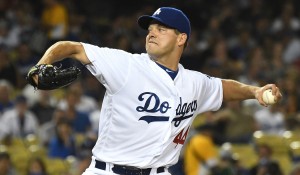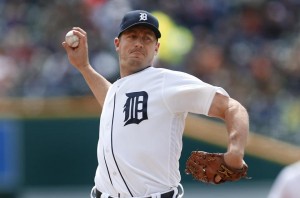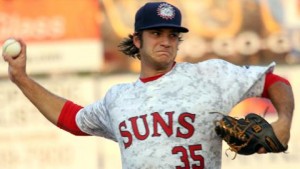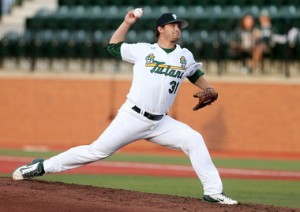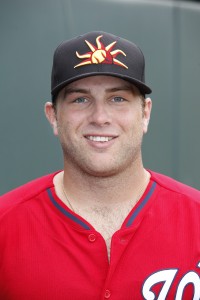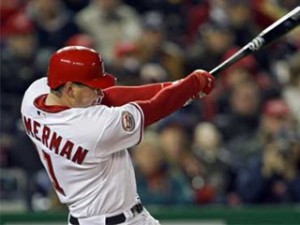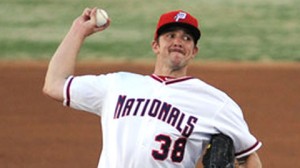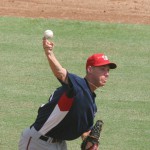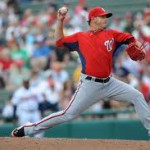
Yunesky Maya is “Really Old” for AAA; but does it matter? Photo unknown
A recurring statement that you often hear when talking about prospects in the minors is “Age Appropriateness” for the level in which the player is playing. And for good reason; a seasoned minor league player who is playing against younger, weaker competition should have dominant numbers, and when analyzing that player’s performance this should be taken into account. On the flip side, if a guy advances quickly up the minors and is a “youngster” at a high level and performs poorly, he shouldn’t immediately be written off, since he’s likely overmatched and needs time to “grow” into the level.
This topic comes up here often when talking about pitchers and their performances, and I frequently talk about a guy “being old” or “being young” for his level as a way to either discount good performances or explain away poor ones. But what is “Too old for a level?”
I have always used a rule-of-thumb measurement advocated by John Sickels at minorleagueball.com for looking at player ages (I cannot find the original Sickels posting but have seen it attributed to him in several forums). That rule-of-thumb is as follows:
- AAA: Typical Age range is 23-24. Age 25 depends. 26+ is old
- AA: 22-23. 24 depends. 25+ is old
- High-A: 20-22. 23 depends. 24+ is old
- Low-A: 19-21. 22 depends. 23+ is old
- Short-A: 19-20. 21/22 for draft year guys only. 22+ is old
- GCL: 17-19. 20 for draft year guys only. 21+ is old
Now, the caveats to the above are as follows:
1. This is specifically worried about prospect development; clearly we know that a former major leaguer on a minor league free agent contract in AAA is going to look like he’s really “old” for the level when we need understand his presence there differently. A rising prospect who is in AAA at the age of 26 or 27 who hasn’t made it to the majors yet is absolutely “old” and is probably closer to minor league free agency or a release than he is to making the big team.
2. Injuries matter. If a college grad loses a year to TJ surgery and then is sitting in high-A as a 24 year old in his second pro season (think Nathan Karns) you can’t really hold that against him. But if he’s dominant, you can sort of explain why and say that he needs to be moved up.
Luke Erickson (with Brian Oliver‘s help) came up with similar looking ranges for the various levels and have made it a link off the main page of NationalsProspects.com. And I talked about this topic a couple of years ago in this space in advance of this same analysis, which I last performed in 2011.
Without further ado, here’s a look at the actual age ranges of the Nationals four full season minor league teams as they stood on 2013’s Opening Day (yes, i’ve had this data in the can for a month and a half and am just getting around to publishing it). I last did this analysis two years ago and it is interesting to see how the age ranges have changed slightly over the years. Here’s 2011’s and 2013’s ranges (click here for a Google spreadsheet of all the detail to check my work and do your own sorting; this link is also in the Links to the right):
| 2011 |
AAA |
AA |
High-A |
Low-A |
| Really Young |
25.54 or younger |
24.44 or younger |
22.65 or younger |
21.88 or younger |
| Young |
25.54 – 26.93 |
24.44 – 25.37 |
22.65 – 23.83 |
21.88 – 22.84 |
| Old |
26.93 – 28.79 |
25.37 – 26.65 |
23.83 – 24.77 |
22.84 – 23.65 |
| Really Old |
28.79 or older |
26.65 or older |
24.77 or older |
23.65 or older |
|
|
|
|
|
| 2013 |
AAA |
AA |
High-A |
Low-A |
| Really Young |
25.91 or younger |
24.02 or younger |
23.08 or younger |
21.69 or younger |
| Young |
25.92 – 27.75 |
24.02 – 25.17 |
23.08 – 24.00 |
21.69 – 22.66 |
| Old |
27.75 – 30.35 |
25.17 – 26.84 |
24.00 – 24.91 |
22.66 – 23.39 |
| Really Old |
30.35 or older |
26.84 or older |
24.91 or older |
23.39 or older |
Data Taxonomy: I’ve taken every pitcher on every team’s roster in each of the four leagues that the Nats have farm teams in (AAA = International, AA = Eastern, High-A = Carolina, Low-A = South Atlantic), put them into a spreadsheet, calculated their ages at the end of this season (9/1/13) and then calculated the four quartile figures in terms of age. I only used pitchers in our leagues as opposed to the entire level across all of baseball thinking that different leagues may have different needs (I’m thinking how the California League and the Pacific Coast League has so many hitters parks and thus the pitchers may linger there longer, skewing the numbers). I also standardized the numbers to be at the end of the season as opposed to the beginning, so that people can talk about a player’s “Age 25 season” for example.
So (using 2013’s AAA as an example): the 25th percentile age is 25.91, the 50th percentile or median age is 27.75, the 75th percentile age is 30.35. For ease of labeling, anyone in the lowest quartile is “Really Young” for that level, 25th-50th is “Young,” 50th-75th is “Old” and anyone in the 75th percentile or higher is labeled “Really Old.” I know some don’t like these labels; if someone just moves past the 50th percentile they go from being “Young” to “Old” in a hurry. But I have to draw the lines somewhere. The fractions are represented as fractions of an entire year of days, so .91 is 91/100ths of 365 days old. This say, as opposed to the way that MLB service time is represented in Years.Days and you see numbers like “1.113.”
Looking at 2011 to 2013’s changes: notice how AAA is getting much older. I think that is due to so many teams giving non-guaranteed MLFA deals to former starters and relievers and stashing them in AAA. Look at our own team: we’ve got guys like Chris Young, Fernando Abad, and JC Romero all in their 30s, skewing the numbers northward. Meanwhile both AA has gotten slightly younger; its median age has dropped slightly.
Here’s a look at the Nationals’ four full season minor league pitching staffs, with the ages listed and the “age appropriate” label given. Note that I did this right at the beginning of the season so I havn’t captured all the moves made in the last month.
AAA Syracuse
| Team |
Name |
DOB |
Age as of 9/1/13 |
Age Status |
| Syracuse (Washington) |
Bill Bray |
6/5/1983 |
30.24 |
Old |
| Syracuse (Washington) |
Cole Kimball |
8/1/1985 |
28.08 |
Old |
| Syracuse (Washington) |
Brad Meyers |
9/13/1985 |
27.97 |
Old |
| Syracuse (Washington) |
Matt Torra |
6/29/1984 |
29.17 |
Old |
| Syracuse (Washington) |
Sean West |
6/15/1986 |
27.21 |
Young |
| Syracuse (Washington) |
Jeremy Accardo |
12/8/1981 |
31.73 |
Really Old |
| Syracuse (Washington) |
Jeff Mandel |
4/30/1985 |
28.34 |
Old |
| Syracuse (Washington) |
Patrick McCoy |
8/3/1988 |
25.08 |
Really Young |
| Syracuse (Washington) |
J.C. Romero |
6/4/1976 |
37.24 |
Really Old |
| Syracuse (Washington) |
Michael Crotta |
9/25/1984 |
28.93 |
Old |
| Syracuse (Washington) |
Bobby Bramhall |
7/13/1985 |
28.14 |
Old |
| Syracuse (Washington) |
Tanner Roark |
10/5/1986 |
26.91 |
Young |
| Syracuse (Washington) |
Ryan Tatusko |
3/27/1985 |
28.43 |
Old |
| Syracuse (Washington) |
Daniel Rosenbaum |
10/10/1987 |
25.89 |
Really Young |
| Syracuse (Washington) |
Ross Ohlendorf |
8/8/1982 |
31.07 |
Really Old |
| Syracuse (Washington) |
Fernando Abad |
12/17/1985 |
27.71 |
Young |
| Syracuse (Washington) |
Erik Davis |
10/8/1986 |
26.90 |
Young |
| Syracuse (Washington) |
Yunesky Maya |
8/28/1981 |
32.01 |
Really Old |
| Syracuse (Washington) |
Ryan Perry |
2/13/1987 |
26.55 |
Young |
| Syracuse (Washington) |
Chris Young |
5/25/1979 |
34.27 |
Really Old |
Discussion: Our “really old” guys are no surprise; they’re all basically guys on MLFA contracts. Well, and Yunesky Maya, who is just playing out the string at this point. I’m more interested in the “prospects” who are in AAA and their age status, and they mostly look good. Pat McCoy and Danny Rosenbaum both rate as really young for the level. Erik Davis and Ryan Perry both rate as young, even despite Perry’s MLB experience. Otherwise are there even other “prospects” worth analyzing on the Syracuse roster at this point? It seems that most everyone else on this team is a backup starter or a backup loogy.
Oldest Guy in the Int’l League: Miguel Batista with Toronto’s AAA affilliate. Yes our own Mr. Batista from two years ago, still hanging around. He’s yet to get called back up in 2013. Ironically the 2nd oldest guy in AAA is also on Buffalo and is also an ex-Nat: Ramon Ortiz, who has gotten called up to help cover for Toronto’s injury-devistated staff and has a couple of apperances already.
Youngest Guy in the Intl’ League: Giovanni Soto with Cleveland’s AAA affilliate in Columbus. He’s not considered a high-end prospect; he’s just a guy drafted out of HS who has made his way level-by-level and is now 22 in AAA. The 2nd youngest guy in AAA is a more familiar name (Trevor Bauer, also with Cleveland’s team) and the ten youngest pitchers in the league reads like a top-50 Pitching prospects list MLB-wide.
Percentage of Int’l League pitchers on MLB 40-man rosters: 65/210 or 30.9%. This shows just how much AAA is turning into a spare-parts holding league.
AA Harrisburg
| Team |
Name |
DOB |
Age as of 9/1/13 |
Age Status |
| Harrisburg (Washington) |
Adam Olbrychowski |
9/7/1986 |
26.98 |
Really Old |
| Harrisburg (Washington) |
Sammy Solis |
8/10/1988 |
25.06 |
Young |
| Harrisburg (Washington) |
Rafael Martin |
5/16/1984 |
29.30 |
Really Old |
| Harrisburg (Washington) |
Cameron Selik |
8/25/1987 |
26.02 |
Old |
| Harrisburg (Washington) |
Paul Demny |
8/3/1989 |
24.08 |
Young |
| Harrisburg (Washington) |
Marcos Frias |
12/19/1988 |
24.70 |
Young |
| Harrisburg (Washington) |
Brian Broderick |
9/1/1986 |
27.00 |
Really Old |
| Harrisburg (Washington) |
Trevor Holder |
1/8/1987 |
26.65 |
Old |
| Harrisburg (Washington) |
Aaron Barrett |
1/2/1988 |
25.66 |
Old |
| Harrisburg (Washington) |
Caleb Clay |
2/15/1988 |
25.54 |
Old |
| Harrisburg (Washington) |
Neil Holland |
8/14/1988 |
25.05 |
Young |
| Harrisburg (Washington) |
Rob Wort |
2/7/1989 |
24.56 |
Young |
| Harrisburg (Washington) |
Pat Lehman |
10/18/1986 |
26.87 |
Really Old |
| Harrisburg (Washington) |
Matt Swynenberg |
2/16/1989 |
24.54 |
Young |
| Harrisburg (Washington) |
Ian Krol |
5/9/1991 |
22.32 |
Really Young |
| Harrisburg (Washington) |
Blake Treinen |
6/30/1988 |
25.17 |
Young |
| Harrisburg (Washington) |
Nathan Karns |
11/25/1987 |
25.77 |
Old |
Borrowing from my Monthly check-in on the Minor League staffs, who are we really interested in on this roster? The rotation is Broderick, Treinen, Demny, Clay and Karns. Broderick is really old for the level, but we already knew that (considering he was in the majors as our Rule-5 draftee two years ago). Karns and Clay are “old” for the level but not overly so; the median age is 25.17 and they’re 25.77 and 25.54 respectively. So just a few months older than the median. Not bad considering Karns basically lost two years of development time due to injuries. When the team gets Solis back, he’ll still be young. And most interestingly is Ian Krol who is the 4th youngest guy in the Eastern League but has dominant numbers thus far in 2013. Most of the “really old” guys are relievers who most would agree are “Org guys” and will naturally fall of the roster when their 6-year FA period arrives.
Oldest Guy in the Eastern League: Willie Collazo on Toronto’s AA team in New Hampshire, who had four years in the PCL and likely is only on a AA roster as a procedural location since he started the season on the DL. In fact, most of that team’s roster is among the 20 oldest guys in the league. And as with the AAA team there are ex-Nats all over their rosters. I think we’re seeing the effects of former Nats front-office member Dana Brown now in Toronto helping to shape their minor league roster with guys he’s familiar with.
Youngest Guy in the Eastern League: One Dylan Bundy, Baltimore farm-hand who already has MLB innings and who some thought could have broken camp with the Orioles. Unfortunatley for Bundy, he’s been sidelined with shoulder issues all year. But he’s clearly an up-and-coming talent. The 2nd youngest guy in the Eastern league is also a big-time prospect: Jamison Taillon in Pittsburgh’s org. In fact, when Taillon and his fellow uber-prospect Gerrit Cole matriculate to the majors, Pittsburgh is going to suddenly find themselves with one of the league’s elite pitching staffs.
Percentage of Eastern League pitchers on MLB 40-man rosters: 15/182 or 8.24%. Just a handful (Nathan Karns is one, Bundy is one).
High-A Potomac
| Team |
Name |
DOB |
Age as of 9/1/13 |
Age Status |
| Potomac (Washington) |
Paul Applebee |
5/17/1988 |
25.29 |
Really Old |
| Potomac (Washington) |
Robert Gilliam |
11/29/1987 |
25.76 |
Really Old |
| Potomac (Washington) |
Josh Smoker |
11/26/1988 |
24.76 |
Old |
| Potomac (Washington) |
Matthew Grace |
12/14/1988 |
24.71 |
Old |
| Potomac (Washington) |
Robbie Ray |
10/1/1991 |
21.92 |
Really Young |
| Potomac (Washington) |
Colin Bates |
3/10/1988 |
25.48 |
Really Old |
| Potomac (Washington) |
A.J. Cole |
1/5/1992 |
21.66 |
Really Young |
| Potomac (Washington) |
Ben Hawkins |
11/4/1989 |
23.82 |
Young |
| Potomac (Washington) |
Tyler Herron |
8/5/1986 |
27.07 |
Really Old |
| Potomac (Washington) |
Gregory Holt |
6/19/1989 |
24.20 |
Old |
| Potomac (Washington) |
Taylor Jordan |
1/17/1989 |
24.62 |
Old |
| Potomac (Washington) |
Christian Meza |
8/3/1990 |
23.08 |
Really Young |
| Potomac (Washington) |
Richie Mirowski |
4/30/1989 |
24.34 |
Old |
| Potomac (Washington) |
Derek Self |
1/14/1990 |
23.63 |
Young |
| Potomac (Washington) |
Taylor Hill |
3/12/1989 |
24.47 |
Old |
| Potomac (Washington) |
Kylin Turnbull |
9/12/1989 |
23.97 |
Young |
Discussion: Our starters at the time of this writing in Potomac are Ray, Jordan, Schwartz, Cole and Hill. Schwartz wasn’t on this roster when I did the cut-n-paste jobs but he’s almost the same identical age as the man he replaced Turnbull. Ray and Cole still rate as “Really Young” (they’re the 7th and 10th youngest guys in the Carolina league) despite both guys repeating this level, a testament to just how young these guys were LAST year. Jordan rates as “old” but with the injury caveat. Hill is four months older than the median age so frankly he’s right on schedule. By and large though this is an older staff, which to me is indicative of the college-heavy pitcher drafts Mike Rizzo has done the last few years. All of our staffs are going to trend old.
Oldest/Youngest Guys in Carolina League: Baltimore’s Frederick affiliate oddly has the two youngest guys (Eduardo Rodriguez, Zachary Davies) and the two oldest guys (Eunchul Choi and Rob Delaney) in the league. I’ve never heard anything about any of these four, so I can’t really add much commentary here 🙂
Percentage of Carolina pitchers on MLB 40-man rosters: Just 2/115 for 1.74%
Low-A Hagerstown
| Team |
Name |
DOB |
Age as of 9/1/13 |
Age Status |
| Hagerstown (Washington) |
Blake Schwartz |
10/9/1989 |
23.90 |
Really Old |
| Hagerstown (Washington) |
Brett Mooneyham |
1/24/1990 |
23.60 |
Really Old |
| Hagerstown (Washington) |
Brian Dupra |
12/15/1988 |
24.71 |
Really Old |
| Hagerstown (Washington) |
Brian Rauh |
7/23/1991 |
22.11 |
Young |
| Hagerstown (Washington) |
Bryan Harper |
12/29/1989 |
23.67 |
Really Old |
| Hagerstown (Washington) |
David Fischer |
4/10/1990 |
23.39 |
Old |
| Hagerstown (Washington) |
Dean Weaver |
5/17/1988 |
25.29 |
Really Old |
| Hagerstown (Washington) |
Dixon Anderson |
7/2/1989 |
24.17 |
Really Old |
| Hagerstown (Washington) |
Ivan Pineyro |
9/29/1991 |
21.92 |
Young |
| Hagerstown (Washington) |
Matt Purke |
7/17/1990 |
23.13 |
Old |
| Hagerstown (Washington) |
Pedro Encarnacion |
6/26/1991 |
22.18 |
Young |
| Hagerstown (Washington) |
Robert Benincasa |
9/5/1990 |
22.99 |
Old |
| Hagerstown (Washington) |
Ronald Pena |
9/19/1991 |
21.95 |
Young |
| Hagerstown (Washington) |
Todd Simko |
12/5/1988 |
24.74 |
Really Old |
| Hagerstown (Washington) |
Travis Henke |
7/9/1988 |
25.15 |
Really Old |
| Hagerstown (Washington) |
Will Hudgins |
2/12/1990 |
23.55 |
Really Old |
| Hagerstown (Washington) |
Wirkin Estevez |
3/15/1992 |
21.46 |
Really Young |
Discussion: as with Potomac, 9 of the 17 guys on this staff are in the “Really Old” category, again a testament to the college-heavy arm drafting of late. Even Brett Mooneyham is now on the old side of the league median age, and he’s just got one full pro season under his belt. The one guy listed as “Really Young” is DSL grad Wirkin Estevez
Oldest Guy in the Sally League: Miami’s low-A affiliate in Greensboro has a guy who is already 28 named Miguel Fermin. He’s in low-A because he’s converting to be a Pitcher after 6 years as a middle infielder.
Youngest Guy in the Sally League: Atlanta’s Lucas Sims, their 1st round draft pick from 2012, who hasn’t even turned 19 as of today (but will have by the end of the season). The 2nd youngest is a lefty prep draftee in Baltimore’s system named Josh Hader who has an interesting story thus far; he was a HS draftee in the 19th round who put up great numbers in short-season last year, broke with the low-A team and has a 1.74 ERA through four starts as of the time of this writing. Sounds like a heck of a draft find for Baltimore so far.
Percentage of Sally League pitchers on MLB 40-man rosters: 1 of 196 pitchers. That one? our very own Matt Purke, who at this point, I’m not afraid to say, looks like he could be a draft bust. Not a major one though mind you; the Nats bribed him out of his college commitment with a 3rd round pick but mid first round money in 2011. But that could end up being a lost 3rd round pick unless Purke can show us something this year. In some ways it was a great gamble to get a guy who was 15-0 as a freshman … and “its just money” right? If this kind of draft money allocation were to have happened in the new system, and the team blew its entire wad of money on one injury-prone guy, we’d be much more concerned.
